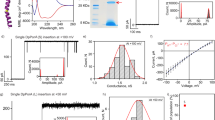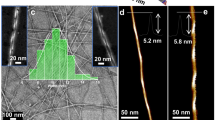Abstract
Natural pore-forming proteins act as viral helical coats1 and transmembrane channels2,3,4, exhibit antibacterial activity5 and are used in synthetic systems, such as for reversible encapsulation6 or stochastic sensing7. These diverse functions are intimately linked to protein structure1,2,3,4. The close link between protein structure and protein function makes the design of synthetic mimics a formidable challenge, given that structure formation needs to be carefully controlled on all hierarchy levels, in solution and in the bulk. In fact, with few exceptions8,9, synthetic pore structures capable of assembling into periodically ordered assemblies that are stable in solution and in the solid state10,11,12,13 have not yet been realized. In the case of dendrimers, covalent14 and non-covalent15 coating and assembly of a range of different structures15,16,17 has only yielded closed columns18. Here we describe a library of amphiphilic dendritic dipeptides that self-assemble in solution and in bulk through a complex recognition process into helical pores. We find that the molecular recognition and self-assembly process is sufficiently robust to tolerate a range of modifications to the amphiphile structure, while preliminary proton transport measurements establish that the pores are functional. We expect that this class of self-assembling dendrimers will allow the design of a variety of biologically inspired systems with functional properties arising from their porous structure.
This is a preview of subscription content, access via your institution
Access options
Subscribe to this journal
Receive 51 print issues and online access
$199.00 per year
only $3.90 per issue
Buy this article
- Purchase on Springer Link
- Instant access to full article PDF
Prices may be subject to local taxes which are calculated during checkout





Similar content being viewed by others
References
Klug, A. From macromolecules to biological assemblies. Angew. Chem. Int. Edn Engl. 22, 565–582 (1983)
Doyle, D. A. et al. The structure of the potassium channel: molecular basis of K+ conduction and selectivity. Science 280, 69–77 (1998)
Murata, K. et al. Structural determinants of water permeation through aquaporin-1. Nature 407, 599–605 (2000)
van den Berg, B. et al. X-ray structure of a protein conducting channel. Nature 427, 36–44 (2004)
Fernandez-Lopez, S. et al. Antibacterial agents based on the cyclic D,L-α-peptide architecture. Nature 412, 452–455 (2001)
Ishii, D. et al. Chaperonin-mediated stabilization and ATP-triggered release of semiconductor nanoparticles. Nature 423, 628–632 (2003)
Bayley, H. & Cremer, P. S. Stochastic sensors inspired by biology. Nature 413, 226–230 (2001)
Ghadiri, M. R., Granja, J. R., Millligan, R. A., McRee, D. E. & Khazanovich, N. Self-assembling organic nanotubes based on a cyclic peptide architecture. Nature 366, 324–327 (1993)
Schmitt, J.-L., Stadler, A.-M., Kyritsakas, N. & Lehn, J.-M. Helicity encoded molecular strands: efficient access by the hydrazone route and structural features. Helv. Chim. Acta 86, 1598–1624 (2003)
Lehn, J.-M. Supramolecular Chemistry. Concepts and Perspectives 118 (VCH, Weinheim, 1995)
Bong, D. T., Clark, T. D., Granja, J. R. & Ghadiri, M. R. Self-assembling organic nanotubes. Angew. Chem. Int. Edn Engl. 40, 989–1011 (2001)
Hill, D. J., Mio, M. J., Prince, R. B., Hughes, T. S. & Moore, J. S. A field guide to foldamers. Chem. Rev. 101, 3893–4011 (2001)
Sakai, N. & Matile, S. Synthetic multifunctional pores: lessons from rigid-rod β-barrels. Chem. Commun., 2514–2523 (2003)
Percec, V. et al. Controlling polymer shape through the self-assembly of dendritic side-groups. Nature 391, 161–164 (1998)
Percec, V. et al. Self-organization of supramolecular helical dendrimers into complex electronic materials. Nature 419, 384–387 (2002)
Percec, V., Cho, W.-D., Ungar, G. & Yeardley, D. J. P. Synthesis and NaOTf mediated self-assembly of monodendritic crown-ethers. Chem. Eur. J. 8, 2011–2025 (2002)
Hudson, S. D. et al. Direct visualization of individual cylindrical and spherical dendrimers. Science 278, 449–452 (1997)
Percec, V., Cho, W.-D., Ungar, G. & Yeardley, D. J. P. Synthesis and structural analysis of two constitutional isomeric libraries of AB2-based monodendrons and supramolecular dendrimers. J. Am. Chem. Soc. 123, 1302–1315 (2001)
Nelson, J. C., Saven, J. G., Moore, J. S. & Wolynes, P. G. Solvophobically driven folding of nonbiological oligomers. Science 277, 1793–1796 (1997)
Brunsveld, L., Zhang, H., Glasbeek, M., Vekemans, J. A. J. M. & Meijer, E. W. Hierarchical growth of chiral self-assembled structures in protic media. J. Am. Chem. Soc. 122, 6175–6182 (2000)
Chan, H. S., Bromberg, S. & Dill, K. A. Models of cooperativity in protein folding. Phil. Trans. R. Soc. Lond. B 348, 61–70 (1995)
Engelkamp, H., Middelbeek, S. & Nolte, R. J. M. Self-assembly of disk-shaped molecules to coiled-coil aggregates with tunable helicity. Science 284, 785–788 (2001)
Hirschberg, J. H. K. K. et al. Helical self-assembled polymers from cooperative stacking of hydrogen-bonded pairs. Nature 407, 167–170 (2000)
Balagurusamy, V. S. K., Ungar, G., Percec, V. & Johansson, G. Rational design of the first spherical supramolecular dendrimers self-organized in a novel thermotropic cubic liquid-crystalline phase and the determination of their shape by X-ray analysis. J. Am. Chem. Soc. 119, 1539–1555 (1997)
Hummer, G., Rasaiah, J. C. & Noworita, J. P. Water conduction through the hydrophobic channel of a carbon nanotube. Nature 414, 188–190 (2001)
Cornelissen, J. J. L. M. et al. β-Helical polymers from isocyanopeptides. Science 293, 676–680 (2001)
Rigaud, J.-L., Pitard, B. & Levy, D. Reconstitution of membrane proteins into liposomes: application to energy-transducing membrane proteins. Biochim. Biophys. Acta 1231, 223–246 (1995)
Finikova, O. et al. Porphyrin and tetrabenzoporphyrin dendrimers: tunable membrane-impermeable fluorescent pH nanosensors. J. Am. Chem. Soc. 125, 4882–4893 (2003)
Ghadiri, M. R., Granja, J. R. & Buehler, L. K. Artificial transmembrane ion channels from self-assembling peptide nanotubes. Nature 369, 301–304 (1994)
Emrick, T. & Fréchet, J. M. J. Self-assembly of dendritic structures. Curr. Opin. Colloid Interface Sci 4, 15–23 (1999)
Acknowledgements
Financial support by the National Science Foundation, the Office of Naval Research and the P. Roy Vagelos Chair at the University of Pennsylvania is acknowledged. J.S. thanks the Isabel and Alfred Bader Foundation for a graduate fellowship, and U.E. acknowledges a Hans Werthén scholarship for postdoctoral studies. We also thank S.Z.D. Cheng for density measurements, and G. Ungar for reading the draft manuscript and for suggestions.
Author information
Authors and Affiliations
Corresponding author
Ethics declarations
Competing interests
The authors declare that they have no competing financial interests.
Supplementary information
Supplementary Information
Self-assembly of amphiphilic dendritic dipeptides into helical pores. (PDF 2432 kb)
Rights and permissions
About this article
Cite this article
Percec, V., Dulcey, A., Balagurusamy, V. et al. Self-assembly of amphiphilic dendritic dipeptides into helical pores. Nature 430, 764–768 (2004). https://doi.org/10.1038/nature02770
Received:
Accepted:
Issue Date:
DOI: https://doi.org/10.1038/nature02770
This article is cited by
-
A General Approach for Synthesis of Circularly Assembled Supramolecular Polymers by Means of Region-confined Amphiphilic Supramolecular Polymerization
Chemical Research in Chinese Universities (2023)
-
Unveiling host–guest–solvent interactions in solution by identifying highly unstable host–guest configurations in thermal non-equilibrium gas phase
Scientific Reports (2022)
-
A bibliometric study on biomimetic and bioinspired membranes for water filtration
npj Clean Water (2021)
-
In situ Activatable Peptide-based Nanoprobes for Tumor Imaging
Chemical Research in Chinese Universities (2021)
-
Catalytically-active porous assembly with dynamic pulsating motion for efficient exchange of products and reagents
Communications Chemistry (2020)
Comments
By submitting a comment you agree to abide by our Terms and Community Guidelines. If you find something abusive or that does not comply with our terms or guidelines please flag it as inappropriate.



